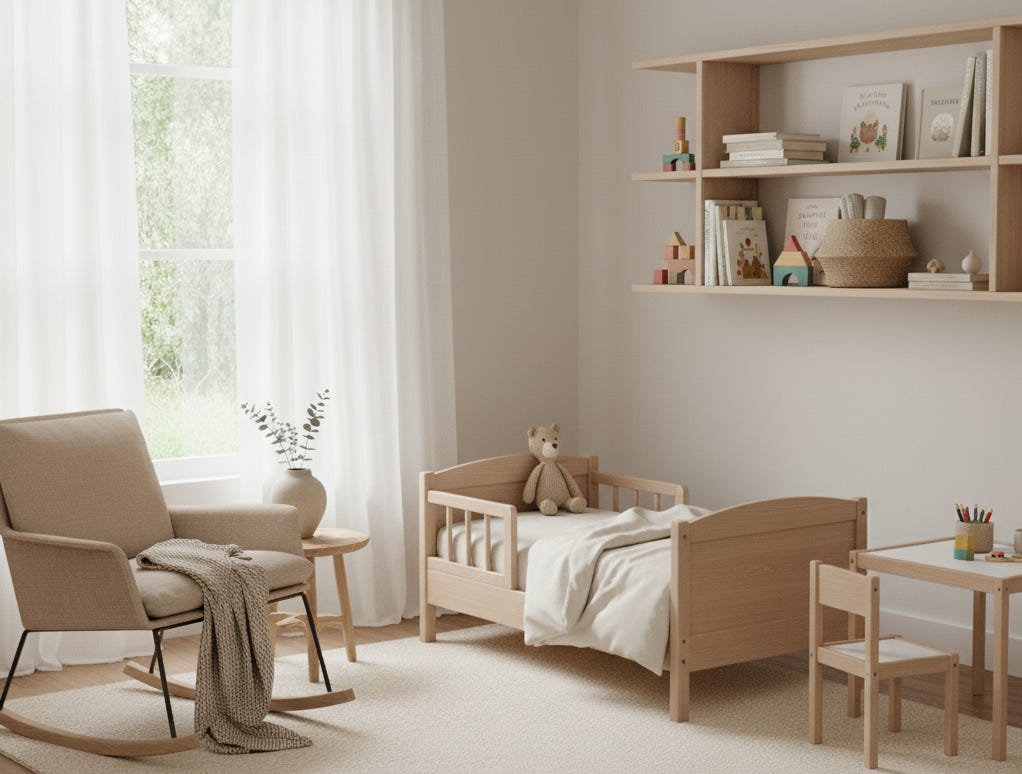6 Ways to Curb Overstimulation and Raise a Calm Baby
Mindful subtraction for better sleep, focus, and mood
When we had our first child, friends passed along bins of onesies, boxes of board books, baskets of rattles and teethers. We felt incredibly lucky.
But as the piles grew, our son’s spaces became chaotic. Overstimulating for him and overwhelming for us.
Surrounded by too much clutter and too many options—too many brightly colored, loudly beeping plastic toys—he’d get manic and distracted. He’d flit from thing to thing without engaging and struggle to wind down for bed.
So we got intentional about reducing excess stimuli in his environment. The difference has been remarkable: better focus, easier emotional regulation, deeper sleep. The best part? None of these changes required expensive purchases.
Here are our six tips for curbing overstimulation and raising a calmer, happier baby.
1) Reduce clutter
Keep spaces organized with designated places for things. Boxes in a corner work fine, nothing fancy needed.
Visible clutter creates constant distraction and requires the baby’s developing brain to work harder. A clear room offers a crucial visual “off-switch” that allows the nervous system to rest.
We try to tidy up most days and teach our son to do it with us. It’s become part of our bedtime routine.
2) Reduce busy colors and patterns
When choosing clothes, toys or feeding products, choose muted, pastel colors over vibrant ones.
Young children’s developing brains can become overwhelmed by high-contrast patterns and saturated colors, which demand more cognitive energy to process. Softer, muted tones create a more restful visual environment that supports calm and focus.
As we develop products for Haomomo, we’re choosing pastel and muted colors for this reason, creating feeding essentials that are both functional and visually gentle.
3) Reduce bright lights at bedtime
When winding down for bed, use dimmable, warm lights positioned lower to the floor instead of overhead fixtures. Go for warm light with red/yellow/orange tones.
Overhead light signals daytime to the brain, interfering with sleep preparation. Lower, warm light mimics sunset and contains fewer blue wavelengths that suppress melatonin. Supporting natural circadian rhythm this way is critical for healthy sleep patterns.
We’re gradually swapping overhead fixtures for lower lamps we can dim during our bedtime routine.
4) Reduce loud, artificial sounds
Limit toys that play loud, artificial sounds like beeps, buzzes, jingles, and sirens. Banish them from sleep spaces entirely. Keep white noise machines at a safe, low level.
Unpredictable, artificial sounds create stress responses in the nervous system. Consistent, soothing low-level background sound masks jarring household noises without adding stimulation that interferes with rest.
We ditched our electronic songbook and now sing softly to our son before bed. He enjoys it so much that he tries to sing with us!
5) Reduce synthetic textures
Swap plastic toys for wood. Ensure fabrics in clothes and textiles are primarily natural like wools and cottons.
Natural materials provide gentle, predictable input that the brain processes as safe and soothing. Synthetic materials can feel unpredictable or overly smooth in ways that offer less sensory information, sometimes triggering subtle stress responses.
We’ve been gradually making this swap over the last year, prioritizing items our son touches most frequently.
6) Reduce options
Put out only a handful of toys or books at a time. Put out a few crayons instead of the whole box. Offer three to five puzzle pieces instead of the full set.
This approach is rooted in Montessori philosophy, which emphasizes environments that support focused engagement. Too much choice overwhelms kids just like it overwhelms adults.
Intentional scarcity isn’t about deprivation. It’s about removing excess so kids can actually engage.
We’ve seen our son display longer focus and deeper engagement when fewer options are available.
The bottom line
Taming overstimulation boils down to a simple idea: mindful subtraction. By creating a tranquil, natural, low-stimulation environment, you set the stage for happier moments for both baby and parents.
What’s one tip you want to implement today to reduce overstimulation in your space?



